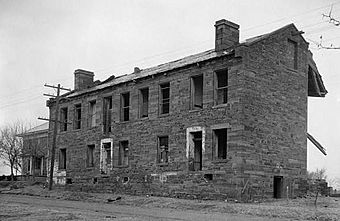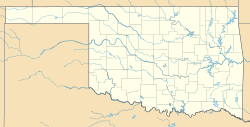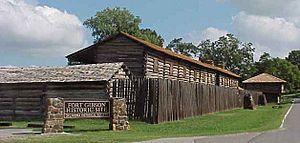Fort Gibson facts for kids
|
Fort Gibson
|
|

Fort Gibson Barracks Building in 1934
|
|
| Location | Fort Gibson, Oklahoma |
|---|---|
| Area | 42 acres (17 ha) |
| Built | 1824 |
| Architect | Matthew Arbuckle |
| NRHP reference No. | 66000631 |
Quick facts for kids Significant dates |
|
| Added to NRHP | October 15, 1966 |
| Designated NHL | December 19, 1960 |
Fort Gibson is a historic military base located near the modern town of Fort Gibson in Oklahoma. It was an important place on the American frontier from 1824 to 1888. When it was first built, Fort Gibson was the westernmost military post in the United States.
It was part of a line of forts meant to keep peace on the edge of the American West. It also protected the southwestern border of the Louisiana Purchase. For over 50 years, the fort successfully kept the peace, with no major battles or massacres happening there. Today, the Oklahoma Historical Society manages the site as the Fort Gibson Historical Site. It is recognized as a National Historic Landmark.
Contents
Building Fort Gibson: A New Frontier Post
Why Fort Gibson Was Built
In 1824, Colonel Matthew Arbuckle led soldiers from the 7th Infantry Regiment (United States) to a new spot. On April 21, 1824, they set up a temporary camp called Cantonment Gibson. This camp was located on the Grand River (Oklahoma), where it meets the Arkansas River. It was one of many forts built to protect America's western border and the large area of the Louisiana Purchase.
Naming the Fort and Early Days
The US Army named the fort after Colonel George Gibson, who was in charge of army supplies. From 1824, the fort's doctor started keeping weather records. These are the oldest known weather records in Oklahoma. Colonel Arbuckle also helped establish Fort Towson in southern Indian Territory.
Life at the Fort
In its early years, soldiers built a stockade (a fence of strong posts), barracks (buildings for soldiers), and other facilities. They also built roads. A big part of their job was to help solve problems between the Osage Nation, who had lived there for a long time, and the first groups of Cherokee settlers.
Fort Gibson and the Indian Removal Act
A New Mission for the Fort
In 1830, the US Congress passed the Indian Removal Act. This law changed the main job of Cantonment Gibson. In 1832, the camp became Fort Gibson, showing it was now a permanent military base. Soldiers at Fort Gibson increasingly dealt with Native American tribes who were forced to move from their homes in the eastern states to Indian Territory.
Helping New Arrivals and Keeping Peace
These new arrivals often complained about problems with the Osage Nation and other Plains Indian tribes already living in the area. A group led by Montfort Stokes met at Fort Gibson to help solve these issues. The fort's soldiers supported their efforts.
Exploring the Plains
In 1832, American author Washington Irving joined soldiers exploring the southern Plains west of Fort Gibson. He wrote a book called A Tour of the Prairies in 1835 about his experiences. In 1834, General Henry Leavenworth led the First Dragoon Expedition on a peace mission to the west. This expedition finally met with nomadic Indian tribes. The artist George Catlin traveled with them and drew many pictures.
Challenges for Soldiers
General Leavenworth sadly passed away during the march, and Colonel Henry Dodge took command. The expedition made the first treaty with these tribes. Many soldiers got very sick and sadly passed away from fevers during this trip. One officer said these expeditions felt like "a veritable death sentence." During these years, soldiers built roads, provided supplies for the arriving Native Americans, and worked to keep peace among different tribes.
Fort Gibson During the Texas Revolution
When the Texas Revolution began, most of Fort Gibson's soldiers were sent to the Texas border. Even with fewer soldiers, the fort still managed to keep the area stable.
Famous Visitors and Leaders
In the 1830s, Fort Gibson had the largest group of soldiers in the country. Many famous American soldiers served or visited there, including Stephen W. Kearny, Robert E. Lee, and Zachary Taylor. Jefferson Davis, who later became president of the Confederate States of America, was also stationed at the fort. Nathan Boone, son of the famous explorer Daniel Boone, was assigned there too. Sam Houston, who later became a leader in Texas, owned a trading post nearby.
Resolving Tribal Disputes
In 1836, a meeting at Fort Gibson had strong disagreements. Most of the Muscogee (Creek) tribe reluctantly accepted their existing government. Colonel Arbuckle also tried to prevent arguments within the Cherokee tribe. However, Chief John Ross and his followers did not agree with the government set up by earlier Cherokee settlers. After fighting in the Florida Seminole Wars, many Seminole people arrived in Indian Territory feeling sad and tired. Officials at Fort Gibson worked to prevent fighting and disunity among them.
Peacekeeping and First Closure
A Time of Peace
When Colonel Arbuckle left Fort Gibson in 1841, he reported great success. He said that even with 40,000 Native Americans from the east arriving, he had kept peace on the frontier. He noted that both white settlers and Native Americans were safer than ever before. Over time, the Native American nations who had moved there felt less need for military protection.
Complaints and Closure
In the 1850s, the Cherokee tribe complained about problems like alcohol sales at Fort Gibson. They tried to stop alcohol from being sold to their people. Eventually, the Cherokee asked Congress to close Fort Gibson. The War Department agreed. On May 7, 1857, the fort was closed for the first time. The Cherokee Nation received the land and buildings. They then established the village of Kee-too-wah on the site. This village became a center for traditional Cherokee people.
Fort Gibson During the American Civil War
Union Control
During the American Civil War, Union soldiers sometimes used Fort Gibson. In the summer of 1862, Union troops stopped a Confederate attack on Indian Territory. They then left the fort and went to Kansas. In April 1863, Colonel William A. Phillips and his Indian Home Guard (a Union Native American brigade) took back Fort Gibson. They held it for the rest of the war.
Renaming and Key Battles
The Army briefly renamed the post Fort Blunt after Brigadier General James G. Blunt. The fort was important because it controlled the area where the Arkansas River and Texas Road met. Confederates never directly attacked the fort. However, a fight over the fort's livestock grew into a big battle nearby, known as the battle of Fort Gibson. In July 1863, troops from Fort Gibson, led by General Blunt, marched south. They won the Battle of Honey Springs, which was the most important battle in Indian Territory.
In the summer of 1864, a steamboat called the J.R. Williams traveled up the Arkansas River. It carried food and supplies for Union troops at Fort Gibson. Cherokee General Stand Watie, who was mostly cut off from the rest of the Confederacy, wanted to capture the boat and its supplies. The fight that followed is the only naval battle ever fought in Oklahoma/Indian Territory history.
After the War
After the American Civil War, the US Army kept Fort Gibson. Lasting peace with the Indian tribes of the southern Plains was finally achieved after 1870. However, forts further west took on more of the job of keeping that peace. Fort Gibson had successfully kept peace in its area for over 50 years. In 1871, most soldiers were moved elsewhere. Only a small group remained to manage supplies.
Cavalry Returns to Fort Gibson
Policing the Railroad
In 1872, the Tenth Cavalry returned to Fort Gibson. Soon after, workers began building the Missouri–Kansas–Texas Railroad. This railroad would connect Baxter Springs, Kansas, to the Red River crossing at Colbert's Ferry, near the Texas border. This new railroad would help transport cattle and goods. The cavalry from Fort Gibson helped police the workers' camps.
Maintaining Order
Soldiers worked to handle threats from outlaws, white settlers moving onto Native American lands, and arguments between tribes. The number of soldiers at the fort changed depending on how much work there was to do.
The Fort's Final Days
In 1888, the Kansas and Arkansas Valley Railway built tracks through the area. The town of Fort Gibson, Oklahoma began to grow. In the summer of 1890, the Army left Fort Gibson for the last time. Sometimes, soldiers would camp at the site if there was trouble in the town, which had taken the fort's name. After the military left for good, the civilian town expanded into the old fort grounds.
Fort Gibson: A Historic Site Today
Restoration and Recognition
In the 1930s, during the Great Depression, the Works Project Administration helped rebuild some of the fort's buildings. This was part of a government effort to preserve history and create jobs. In 1960, the National Park Service named Fort Gibson a National Historic Landmark.
Visiting the Site
The old fort is located in present-day Muskogee County, Oklahoma, at Lee and Ash Streets in Fort Gibson, Oklahoma. The Oklahoma Historical Society manages the site. Visitors can see a reconstructed log fort from the early days and original buildings from the 1840s to the 1870s. The Commissary Visitor Center has museum exhibits about the fort's history. The site also hosts special living history events and programs.
Fort Gibson National Cemetery is located a few miles away.
See also
- List of National Historic Landmarks in Oklahoma
- Oldest buildings in Oklahoma





